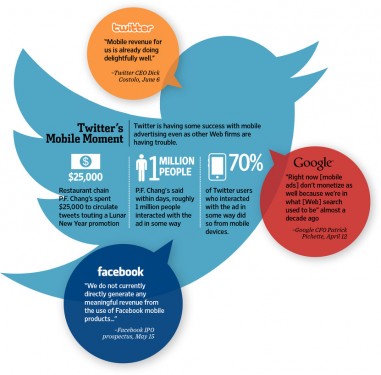Twitter has introduced a vast number of changes to bring users back to its native product and the official Twitter app.
Beyond the new branding rules and how its new logo shouldn’t be modified, as outlined by clicking here Twitter has evolved it’s strategy in the following ways:
As of June 29, 2012, Tweets will no longer be displayed on LinkedIn.
LinkedIn and Twitter have worked together since 2009 to enable you to share your professional conversations on both platforms. Twitter has now changed the way Tweets appear in third-party applications.
This is a bit of an odd move considering that by sharing updates from Twitter to LinkedIn it provides added exposure for the social network to your professional contacts on LinkedIn.
It’s also a disappointing move from the angle that Twitter gave a lot of professional profiles more of personalized voice.
You will still be able to share updates with your greater audience by composing your updates on LinkedIn and check the Twitter Icon box and click “Share.” This will automatically push your update to both your LinkedIn connections and your Twitter followers just as before.
But the conversation has to start on LinkedIn, rather than having your Tweets appear on your LinkedIn news feed. Any conversation you start on Twitter will no longer be automatically shared with your LinkedIn network, even if you synced your LinkedIn and Twitter accounts.
THIRD-PARTY APPS and API
Now it appears that Twitter is about to get a lot stricter with how developers work with the site and the products they create. Twitter appears to be enforcing stricter guidelines about how the Twitter API is used.
On the Twitter developers blog, the latest post from Twitter’s Group Product Manager Michael Sippey says that the micro-blogging site is preparing to crack down on third-party developers. After talking about how the company strives to ensure a consistent experience, Sippey writes:
These efforts highlight the increasing importance of us providing the core Twitter consumption experience through a consistent set of products and tools. Back in March of 2011, my colleague Ryan Sarver said that developers should not “build client apps that mimic or reproduce the mainstream Twitter consumer client experience.” That guidance continues to apply as much as ever today. Related to that, we’ve already begun to more thoroughly enforce our Developer Rules of the Road with partners, for example with branding, and in the coming weeks, we will be introducing stricter guidelines around how the Twitter API is used.”
While the final paragraph says that Twitter is looking forward to working with developers, the message is pretty clear: Start playing by our rules and stop creating apps that mimic our product. Sippey says that the reason Twitter is enforcing this is because
you need to be able to see expanded Tweets (sic) and other features that make Twitter more engaging and easier to use.”
While this could be the case, it’s rather obvious that advertisement revenue plays a part in this too. Currently, promoted tweets, trends and accounts only appear on Twitter’s native site and app and nowhere else. By getting third-party apps to comply and start integrating the company’s products into their own apps, it would mean that ads would also be integrated.
Third-party apps are depriving the original twitter site of traffic and also impact on the visibility of Twitter’s Ads. If nobody is visiting the main site and app, then users won’t see the advertisements and Twitter won’t generate as much revenue as it should.
It will be difficult and expensive for Twitter to police third-party applications as there’s a vast number of them. But this will be made easier by putting regulations such as their logo and branding requirements in place.
MOBILE ADVERTISING
Twitter Inc. is showing early signs of success selling advertising on mobile devices, an area that is bedeviling Internet companies including Facebook Inc. FB -0.85% and Google Inc. GOOG +2.79% **
Twitter executives say that Twitter is now generating the majority of its revenue from ads shown to its users on mobile gadgets, rather than from ads on Twitter.com. One key reason: People who see a Twitter ad on their phones are more likely to click or interact with it in some way, which is how Twitter gets paid for advertisements.
The format of ads on Twitter’s desktop and mobile sites are the same, and advertisers pay the same rate no matter the platform. On many mobile services including Google’s, ad rates are lower in part because advertiser demand is lower.
Twitter says its mobile-advertising business is working because a company can easily convert any tweet into an ad.
Twitter says it is commited to simplicity, transparency, and reaching every person on the planet.
Some other of Twitter’s most recent developments include:
A new weekly email that delivers the most interesting news and items you might have missed from the people you’re connected to on Twitter.
Twitter is available in more languages than ever.
More than 400,000 volunteers have contributed to Twitter’s Translation Center, which takes a crowd-sourced approach to making Twitter available in new languages. In fact, thanks to these passionate people all over the world, Twitter is offered in 21 languages. Thy’ve recently introduced it in Danish, Finnish, Norwegian and Polish — and most recently, Swedish.
As the number of volunteer translators grows, Twitter plans to explore new ways to empower users to translate and localize for even more communities.
You should expect to see further improvements to Twitter’s Translation Center in the coming year, including new translation tools.
Twitter has also made a number of updates to their Privacy Policy and Terms of Service.
There will no doubt be further changes in store from Twitter, “Watch this space!”
** Image and Data Source: http://online.wsj.com/article/SB10001424052702304458604577491170573156612.html?mod=dist_smartbrief

Leave a Reply
You must be logged in to post a comment.